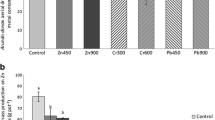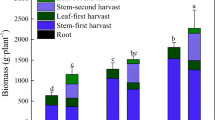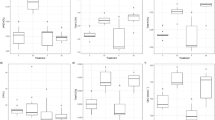Abstract
The aim of this work was to assess the suitability of Miscanthus × giganteus and Spartina pectinata link to Cu, Ni, and Zn phytoremediation. A 2-year microplot experiment with the tested grasses growing on metal-contaminated soil was carried out. Microplots with cement borders, measuring 1 × 1 × 1m, were filled with Haplic Luvisols soil. Simulated soil contamination with Cu, Ni, and Zn was introduced in the following doses in mg kg−1: 0—no metals, Cu1—100, Cu2—200, Cu3—400, Ni1—60, Ni2—100, Ni3—240, Zn1—300, Zn2—600, and Zn3—1200. The phytoremediation potential of grasses was evaluated using a tolerance index (TI), bioaccumulation factor (BF), bioconcentration factor (BCF), and translocation factor (TF). S. pectinata showed a higher tolerance to soil contamination with Cu, Ni, and Zn compared to M. × giganteus. S. pectinata was found to have a high suitability for phytostabilization of Zn and lower suitability of Cu and Ni. M. × giganteus had a lower phytostabilization potential than S. pectinata. The suitability of both grasses for Zn phytoextraction depended on the age of the plants. Both grasses were not suitable for Cu and Ni phytoextraction. The research showed that one-season studies were not valuable for fully assessing the phytoremediation potential of perennial plants.

Similar content being viewed by others
References
Arduini I, Ercoli L, Mariotti M, Masoni A (2006) Response of Miscanthus to toxic cadmium applications during the period of maximum growth. Environ Exp Bot 55:29–40. doi:10.1016/j.envexpbot.2004.09.009
Baker AJM (1981) Accumulators and excluders strategies in the response of plants to heavy metals. J Plant Nutr 3:643–654
Cambrolle J, Mateos-Naranjo E, Redondo-Gomez S, Luque T, Figueroa ME (2011) The role of two Spartina species in phytostabilization and bioaccumulation of Co, Cr, and Ni in the Tinto–Odiel estuary (SW Spain). Hydrobiologia 671:95–103. doi:10.1007/s10750-011-0706-4
Cheraghi M, Lorestani B, Khorasani N, Yousef N, Karami M (2011) Findings on the phytoextraction and phytostabilization of soils contaminated with heavy metals. Biol Trace Elem Res 144(1–3):1133–1141. doi:10.1007/s12011-009-8359-0
Curado G, Rubio-Casal AE, Figueroa E, Castillo JM (2014) Potential of Spartina maritima in restored salt marshes for phytoremediation of metals in a highly polluted estuary. Int J Phytorem 16:1209–1220. doi:10.1080/15226514.2013.821451
Fernando A, Oliveira JS (2004) Effects on growth, productivity and biomass quality of Miscanthus × giganteus of soils contaminated with heavy metals. 2nd World Conference on Biomass for Energy, Industry and Climate Protection, 10–14 May 2004, Rome, Italy, http://moodle.fct.unl.pt/pluginfile.php/92027/mod_resource/content/0/Fernando_e_Oliveira_2004.pdf
Grzebisz W, Gaj R (2001) Phytoremediation—the agro-technological component of the future strategies of soils contaminated by heavy metals remediation. In: Gworek B, Mocek A (eds) The cycle of elements in nature. Instytut Ochrony Srodowiska, Warszawa, pp 337–344
Ho C-P, Hseu Z-H, Chen N-C, Tsai C-C (2013) Evaluating heavy metal concentration of plants on a serpentine site for phytoremediation applications. Environ Earth Sci 70:191–199. doi:10.1007/s12665-012-2115-z
Kabata-Pendias A, Mukherjee AB (2007) Trace elements from soil to human. Springer Verlag, Heidelberg
Kabata-Pendias A, Pendias H (1999) Biogeochemistry of trace elements. PWN, Warszawa (in Polish)
Karczewska A, Lewinska K, Gałka B (2013) Arsenic extractability and uptake by velvetgrass Holcus lanatus and ryegrass Lolium perenne in variously treated soils polluted by tailing spills. J Hazard Mater 262(15):1014–1102. doi:10.1016/j.jhazmat.2012.09.008
Kocon A, Matyka M (2012) Phytoextractive potential of Miscanthus × giganteus and Sida hermaphrodita growing under moderate contamination of soil with Zn and Pb. J Food Agric Environ 10(2):1253–1256
Korzeniowska J, Stanislawska-Glubiak E, Igras J (2011) Applicability of energy crops for metal phytostabilization of soils moderately contaminated with copper, nickel and zinc. J Food Agric Environ 9(3/4):693–697
Li C, Xiao B, Wang QH, Yao SH, Wu JY (2014) Phytoremediation of Zn- and Cr-contaminated soil using two promising energy grasses. Water Air Soil Pollut 225:2027. doi:10.1007/s11270-014-2027-5
Malik RN, Husain SZ, Nazir I (2010) Heavy metal contamination and accumulation in soil and wild plant species from industrial area of Islamabad, Pakistan. Pak J Bot 42(1):291–301
Mann JJ, Barney JN, Kyser GB, DiTomaso JM (2013) Root system dynamics of Miscanthus × giganteus and Panicum virgatum in response to rainfed and irrigated conditions in California. Bioenergy Res 6:678–687. doi:10.1007/s12155-012-9287-y
Mateos-Naranjo E, Redondo-Gómez S, Cambrollé J, Luque T, Figueroa ME (2008) Growth and photosynthetic responses to zinc stress of an invasive cordgrass, Spartina densiflora. Plant Biol 10:754–762. doi:10.1111/j.1438-8677.2008.00098.x
Mateos-Naranjo E, Andrades-Moreno L, Redondo-Gomez S (2011) Comparison of germination, growth, photosynthetic responses and metal uptake between three populations of Spartina densiflora under different soil contamination conditions. Ecotoxicol Environ Saf 74:2040–2049. doi:10.1016/j.ecoenv.2011.06.019
McGrath SP, Zhao F-J (2003) Phytoextraction of metals and metalloids from contaminated soils. Curr Opin Biotechnol 14:277–282
Meers E, Vandecasteele B, Ruttens A, Vangronsveld J, Tack FMG (2007) Potential of five willow species (Salix spp.) for phytoextraction of heavy metals. Environ Exp Bot 60:57–68. doi:10.1016/j.envexpbot.2006. 06.008
Mulligan CN, Yong RN, Gibbs BF (2001) Remediation technologies for metal-contaminated soils and groundwater: an evaluation. Eng Geol 60:193–207
Nalla S, Hardaway CJ, Sneddon J (2012) Phytoextraction of selected metals by the first and second growth seasons of Spartina alterniflora. Instrum Sci Technol 40:17–28. doi:10.1080/10739149.2011.633143
Nsanganwimana F, Pourrut B, Mench M, Douay F (2014) Suitability of Miscanthus species for managing inorganic and organic contaminated land and restoring ecosystem services. A review. J Environ Manag 143:123–134. doi:10.1016/j.jenvman.2014.04.027
Padmavathiamma PK, Li LY (2007) Phytoremediation technology: hyper-accumulation metals in plants. Water Air Soil Pollut 184:105–126. doi:10.1007/s11270-007-9401-5
Peralta-Videa JR, de la Rosaa G, Gonzaleza JH, Gardea-Torresdey JL (2003) Effects of the growth stage on the heavy metal tolerance of alfalfa plants. Adv Environ Res 8:679–685. doi:10.1016/S1093-0191(03)00040-6
Pogrzeba M, Krzyzak J, Sas-Nowosielska A (2013) Environmental hazards related to Miscanthus × giganteus cultivation on heavy metal contaminated soil. In: E3S Web Conference. doi:10.1051/e3sconf/20130129006
Redondo-Gómez S (2013) Bioaccumulation of heavy metals in Spartina. Funct Plant Biol 40:913–921. doi:10.1071/FP12271
Regulation of the Minister of Environment of 9 September 2002 on soil and earth quality standards (2002) Journal of Laws of the Republic of Poland No 165, Item 1359
Roccotiello E, Manfredi A, Drava G, Minganti V, Mariotti M, Berta G, Cornara L (2010) Zinc tolerance and accumulation in the ferns Polypodium cambricum L. and Pteris vittata L. Ecotoxicol Environ Saf 73:1264–1271. doi:10.1016/j.ecoenv.2010.07.019
Sabeen M, Mahmood Q, Irshad M, Fareed I, Khan A, Ullah F, Hussain J, Hayat Y, Tabassum S (2013) Cadmium phytoremediation by Arundo donax L. from contaminated soil and water. BioMed Res Int. doi:10.1155/2013/324830
Stanisławska-Glubiak E, Korzeniowska J (2014) Phytotoxic thresholds for Zn in soil extracted with 1 M HCl. J Food Agric Environ 12(1):146–149
Stanislawska-Glubiak E, Korzeniowska J, Kocon A (2012) Effect of the reclamation of heavy metal-contaminated soil on growth of energy willow. Pol J Environ Stud 21(1):187–192
Stanislawska-Glubiak E, Korzeniowska J, Kocon A (2015) Effect of peat on the accumulation and translocation of heavy metals by maize grown in contaminated soils. Environ Sci Pollut Res 22:4706–4714. doi:10.1007/s11356-014-3706-x
USDA, NRCS (2014) The PLANTS Database. National Plant Data Team, Greensboro, NC 27401–4901 USA. http://plants.usda.gov. Accessed 30 Oct 2014
Wanat N, Austruy A, Joussein E, Soubrand M, Hitmi A, Gauthier-Moussard C, Lenain JF, Vernay P, Munch JC, Pichon M (2013) Potentials of Miscanthus × giganteus grown on highly contaminated technosols. J Geochem Explor 126–127:78–84. doi:10.1016/j.gexplo.2013.01.001
Weiss J, Hondzo M, Biesboer D, Semmens M (2006) Laboratory study of heavy metal phytoremediation by three wetland macrophytes. Int J Phytoremediation 8:245–259. doi:10.1080/15226510600846798
Wilkins DA (1978) The measurement of tolerance to edaphic factors by means of root growth. New Phytol 80:623–633
Yang XE, Baligar VC, Foster JC, Martens DC (1997) Accumulation and transport of nickel in relation to organic acids in ryegrass and maize grown with different nickel levels. Plant Soil 196:271–276
Yoon J, Cao X, Zhou Q, Ma LQ (2006) Accumulation of Pb, Cu, and Zn in native plants growing on a contaminated Florida site. Sci Total Environ 368:456–464. doi:10.1016/j.scitotenv.2006.01.016
Acknowledgments
The work has been prepared as part of Task 2.6, implemented in the Long-Term Program of Institute of Soil Science and Plant Cultivation-State Research Institute, funded by the Polish Ministry of Agriculture and Rural Development
Author information
Authors and Affiliations
Corresponding author
Additional information
Responsible editor: Elena Maestri
Rights and permissions
About this article
Cite this article
Korzeniowska, J., Stanislawska-Glubiak, E. Phytoremediation potential of Miscanthus × giganteus and Spartina pectinata in soil contaminated with heavy metals. Environ Sci Pollut Res 22, 11648–11657 (2015). https://doi.org/10.1007/s11356-015-4439-1
Received:
Accepted:
Published:
Issue Date:
DOI: https://doi.org/10.1007/s11356-015-4439-1




